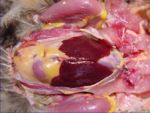Difference between revisions of "Avian Liver - Anatomy & Physiology"
Jump to navigation
Jump to search
m (Text replace - "[[The Proventriculus - Anatomy & Physiology|" to "[[Proventriculus - Anatomy & Physiology|") |
|||
| Line 9: | Line 9: | ||
*Ventral and caudal to the [[Heart - Anatomy & Physiology|heart]] (as there is no diaphragm) | *Ventral and caudal to the [[Heart - Anatomy & Physiology|heart]] (as there is no diaphragm) | ||
| − | *Closely associated to the [[ | + | *Closely associated to the [[Proventriculus - Anatomy & Physiology|proventriculus]] and [[Spleen - Anatomy & Physiology|spleen]] |
*Thin capsule | *Thin capsule | ||
Revision as of 16:45, 7 September 2010
Structure
- 2 lobes
- Dark brown coloured (except just after hatching where it is yellow)
- Right lobe larger than left lobe
- Ventral and caudal to the heart (as there is no diaphragm)
- Closely associated to the proventriculus and spleen
- Thin capsule
- Indistinct lobation
- 2 bile ducts enter the distal duodenum, one from each lobe of the liver
- The duct from the right lobe is connected to the gallbladder
- Hepatic lobules indistinct (except near hilus) due to a lack of perilobular connective tissue
- Avian bile aids the emulsification of fats and contains amylase and lipase
Function
- See liver function
Vasculature
Innervation
Lymphatics
- See liver lymphatics
Histology
Gallbladder: Species Differences
- Pigeons and parrots lack a gall bladder
Test yourself with the Avian Alimentary Tract flashcards
Avian Alimentary Tract Flashcards

